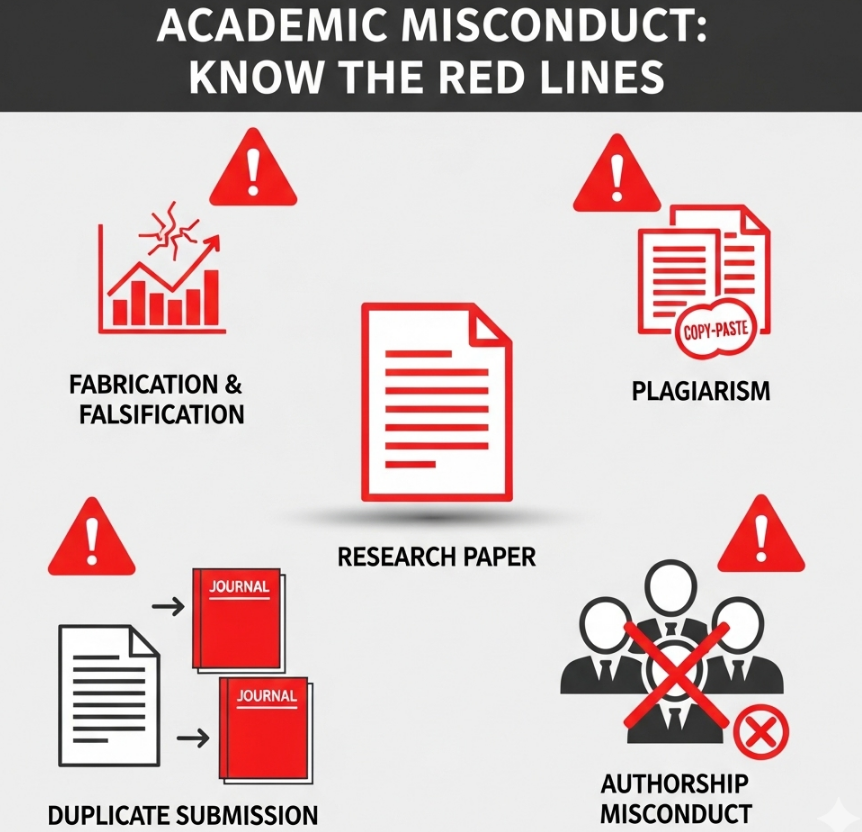Academic integrity is the bedrock of all
scientific and scholarly progress. It's a commitment to honesty, accuracy, and
transparency that ensures the global body of knowledge is trustworthy and
reliable. When this trust is broken through academic misconduct, the
consequences are severe—not just for the individual, but for the entire
research community.
Many forms of misconduct, such as duplicate
submission or data fabrication are considered "academic red lines"
that must never be crossed. This guide clearly defines the most common types of
academic misconduct to help you protect your work, your reputation, and the
integrity of your field.
The Major Forms of Academic Misconduct
These are the most serious offenses in
research and publishing. They are often referred to as FFP (Fabrication,
Falsification, and Plagiarism), but the list extends further.

1. Fabrication: Inventing Data
- What it is: The creation of fake
data, results, or observations. It is, quite simply, making things up and
presenting them as real research.
- Why it's a red line: Fabrication is
the most egregious form of misconduct. It is a deliberate act of deception
that pollutes the scientific record with false information, wasting the
time and resources of other researchers who may try to build upon the
fraudulent work.
- Example: Creating a spreadsheet of
survey results for participants who were never interviewed, or inventing a
series of experimental data points to prove a hypothesis.
2. Falsification: Manipulating Data
- What it is: The alteration,
omission, or manipulation of real research data or results to misrepresent
the findings. Unlike fabrication (which invents data), falsification
starts with real data but distorts it.
- Why it's a red line: It is a
conscious effort to deceive by presenting a skewed or incomplete picture
of the research. It leads to false conclusions and undermines the
scientific process.
- Example: Deleting inconvenient
outlier data points that don't fit a trendline, "cherry-picking"
data that supports a hypothesis while ignoring data that refutes it, or
manipulating images (e.g., selectively cropping a Western blot to hide
unwanted bands).
3. Plagiarism: Using Others' Work
Without Credit
- What it is: The act of taking
someone else's ideas, words, code, or data and presenting them as your own
without proper attribution. This includes "self-plagiarism,"
where you reuse significant portions of your own previously published work
without citing it.
- Why it's a red line: It is
intellectual theft. It violates the fundamental principle of acknowledging
the work of others that your research is built upon.
- Example: Copying a paragraph from
another author's paper and pasting it into your own without using
quotation marks or providing a citation.
4. Duplicate Submission
- What it is: The practice of
submitting the same manuscript to two or more different journals at the
same time.
- Why it's a red line: It unethically
consumes the finite and valuable time of volunteer editors and peer
reviewers at multiple journals for a single piece of work. It can also
lead to duplicate publications, which clutters the academic literature and
can be grounds for retraction.
- Example: Submitting your manuscript
to both Nature Communications and the Journal of the American
Chemical Society simultaneously to see which one accepts it first.
5. Redundant Publication ("Salami
Slicing")
- What it is: The practice of
breaking down a single, substantial study into the smallest possible
"publishable units" to create multiple publications from one set
of data.
- Why it's a red line: While not as
severe as fabrication, it is considered unethical because it artificially
inflates an author's publication list and makes the literature fragmented
and difficult to assess. Each paper must contain a sufficiently novel and
substantial contribution.
- Example: Publishing one paper on
the effect of temperature on a reaction and a second paper on the effect
of pressure from the same experiment, when a single, comprehensive paper
would have been more appropriate.
6. Authorship Misconduct
- What it is: Inappropriately
assigning authorship credit. The author list must accurately reflect who
made significant intellectual contributions to the research.
- Why it's a red line: It
misrepresents who is responsible for the work.
- Examples:
- "Gift" Authorship:
Adding a senior figure or department head to the author list out of
respect, even though they did not contribute, to increase the paper's
chances of acceptance.
- "Ghost" Authorship:
Omitting a deserving junior researcher or technician who made a
significant contribution to the work.
The Consequences of Crossing the Line
Academic misconduct is taken extremely
seriously. The consequences can be career-ending and include:
- Retraction of the publication.
- Notification of the author's institution and funding agencies.
- Loss of funding and academic position.
- Revocation of degrees.
- A permanent ban from publishing in certain journals.
- Irreparable damage to one's professional reputation.
Conclusion
Upholding academic integrity is not a
passive responsibility; it is an active commitment. By understanding these
"red lines" and dedicating yourself to honest, transparent, and
ethical research practices, you contribute to a trustworthy and valuable body
of human knowledge. When in doubt, always seek guidance from a mentor,
supervisor, or your institution's research integrity office.


